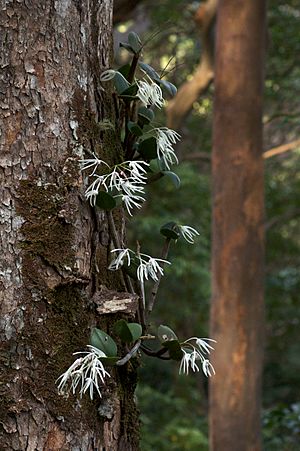Ironbark feather orchid facts for kids
Quick facts for kids Ironbark feather orchid |
|
|---|---|
 |
|
| Dendrobium aemulum in Lamington National Park | |
| Scientific classification | |
| Genus: |
Dendrobium
|
| Species: |
aemulum
|
| Synonyms | |
The Ironbark feather orchid (scientific name: Dendrobium aemulum) is a special type of orchid. It's also called the white feather orchid. This plant is an epiphyte, which means it grows on other plants, usually trees, instead of in the ground. It likes trees that keep their bark, especially ironbark trees. This orchid has reddish or purplish stem-like parts called pseudobulbs. It also has two to four tough, leathery leaves. When it blooms, it can have up to seven white, feathery flowers. You can find it growing in open forests in Queensland and New South Wales, Australia.
Contents
What the Ironbark Feather Orchid Looks Like
The Dendrobium aemulum is an epiphytic herb. This means it's a plant that grows on other plants but doesn't get its food from them. It has hard, straight, reddish or purplish-brown pseudobulbs. These pseudobulbs are like thick stems that store water and nutrients. They are about 50 to 180 millimeters (2 to 7 inches) long and 7 to 12 millimeters (0.3 to 0.5 inches) wide.
The orchid has two to four dark green leaves. These leaves are tough and leathery. They are usually 20 to 50 millimeters (0.8 to 2 inches) long and 20 to 30 millimeters (0.8 to 1.2 inches) wide. The leaves are often folded along their middle.
The flowering stems are 20 to 100 millimeters (0.8 to 4 inches) long. Each stem can have between two and twelve flowers. The flowers are white to pale yellow and are about 17 to 20 millimeters (0.7 to 0.8 inches) long and 20 to 25 millimeters (0.8 to 1 inch) wide.
The top sepal (a leaf-like part that protects the flower bud) is 18 to 25 millimeters (0.7 to 1 inch) long. The side sepals curve downwards and are about 16 to 22 millimeters (0.6 to 0.9 inches) long. The petals are similar in length to the top sepal but are much narrower, only about 1 millimeter (0.04 inches) wide. All the sepals and petals spread out wide and droop. They often turn pink as they get older.
The labellum (the orchid's special lip petal) is also white to pale yellow. It is 6 to 7 millimeters (0.2 to 0.3 inches) long and 5 to 6 millimeters (0.2 inches) wide. It has purplish marks and three parts, called lobes. The side lobes point upwards, and the middle lobe curves downwards.
This orchid usually blooms from August to October. People say the flowers smell sweet at night. This suggests that night-flying insects might help pollinate them.
Naming the Ironbark Feather Orchid
The Dendrobium aemulum was first officially described in 1810. This was done by a botanist named Robert Brown. He published his description in a book called Prodromus Florae Novae Hollandiae et Insulae Van Diemen.
The second part of its scientific name, aemulum, comes from a Latin word. This Latin word means "emulating" or "rivalling".
Where the Ironbark Feather Orchid Grows
The ironbark feather orchid likes to grow on trees that keep their bark. These include ironbark trees, brush box trees (Lophostemon confertus), and cypress pine trees (Callitris species).
You can find this orchid in Australia. It grows from the Calliope Range near Gladstone in Queensland all the way down to Moruya in New South Wales. It lives in open forests, from the coast up to the nearby tablelands.
See also
 In Spanish: Dendrobium aemulum para niños
In Spanish: Dendrobium aemulum para niños

